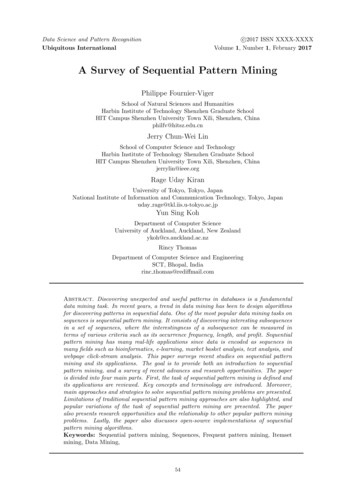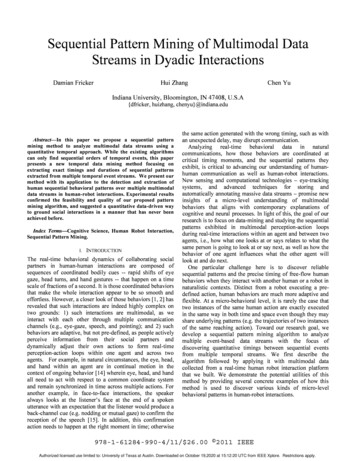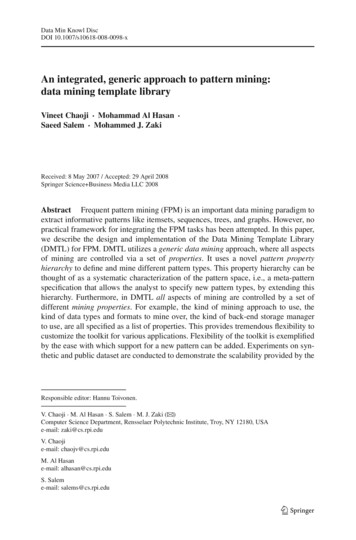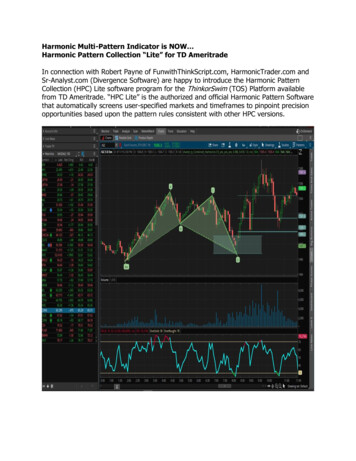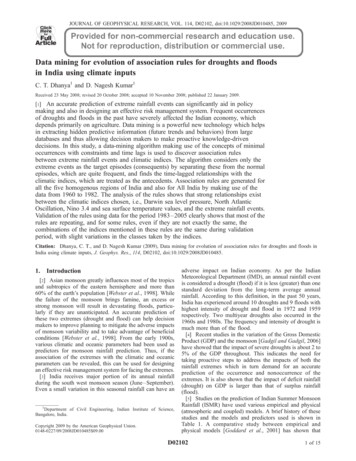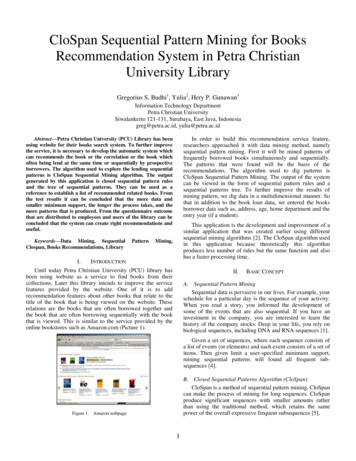
Transcription
CloSpan Sequential Pattern Mining for BooksRecommendation System in Petra ChristianUniversity LibraryGregorius S. Budhi1, Yulia2, Hery P. Gunawan3Information Technology DepartmentPetra Christian UniversitySiwalankerto 121-131, Surabaya, East Java, Indonesiagreg@petra.ac.id, yulia@petra.ac.idIn order to build this recommendation service feature,researchers approached it with data mining method, namelysequential pattern mining. First it will be mined patterns offrequently borrowed books simultaneously and sequentially.The patterns that were found will be the basis of therecommendations. The algorithm used to dig patterns isCloSpan Sequential Pattern Mining. The output of the systemcan be viewed in the form of sequential pattern rules and asequential patterns tree. To further improve the results ofmining pattern, we dig data in a multidimensional manner. Sothat in addition to the book loan data, we entered the booksborrower data such as, address, age, home department and theentry year (if a student).Abstract—Petra Christian University (PCU) Library has beenusing website for their books search system. To further improvethe service, it is necessary to develop the automatic system whichcan recommends the book or the correlation or the book whichoften being lend at the same time or sequentially by prospectiveborrowers. The algorithm used to explore the lending sequentialpatterns is CloSpan Sequential Mining algorithm. The outputgenerated by this application is closed sequential pattern rulesand the tree of sequential patterns. They can be used as areference to establish a list of recommended related books. Fromthe test results it can be concluded that the more data andsmaller minimum support, the longer the process takes, and themore patterns that is produced. From the questionnaire outcomethat are distributed to employees and users of the library can beconcluded that the system can create right recommendations anduseful.Keywords—Data Mining, SequentialClospan, Books Recommendations, LibraryI.PatternThis application is the development and improvement of asimilar application that was created earlier using differentsequential mining algorithms [2]. The CloSpan algorithm usedin this application because theoretically this algorithmproduces less number of rules but the same function and alsohas a faster processing time.Mining,INTRODUCTIONUntil today Petra Christian University (PCU) library hasbeen using website as a service to find books from theircollections. Later this library intends to improve the servicefeatures provided by the website. One of it is to addrecommendation features about other books that relate to thetitle of the book that is being viewed on the website. Theserelations are the books that are often borrowed together andthe book that are often borrowing sequentially with the bookthat is viewed. This is similar to the service provided by theonline bookstores such as Amazon.com (Picture 1).II.BASIC CONCEPTA. Sequential Pattern MiningSequential data is pervasive in our lives. For example, yourschedule for a particular day is the sequence of your activity.When you read a story, you informed the development ofsome of the events that are also sequential. If you have aninvestment in the company, you are interested to learn thehistory of the company stocks. Deep in your life, you rely onbiological sequences, including DNA and RNA sequences [1].Given a set of sequences, where each sequence consists ofa list of events (or elements) and each event consists of a set ofitems. Then given limit a user-specified minimum support,mining sequential patterns will found all frequent subsequences [4].B. Closed Sequential Patterns Algorithm (CloSpan)CloSpan is a method of sequential pattern mining. CloSpancan make the process of mining for long sequences. CloSpanproduce significant sequences with smaller amounts ratherthan using the traditional method, which retains the samepower of the overall expressive frequent subsequences [5].Figure 1. Amazon webpage1
Broadly speaking, CloSpan consists of two main phases,namely: First phase, bring CloSpan LS set, a superset of thefrequent closed sequences, and store it in a prefix sequencelattice, and second phase is post - pruning CloSpan toeliminate non-closed sequences. CloSpan algorithm can beseen in Figure 2 and Figure 3.III.APPLICATION DESIGNThis application is further development of similarapplication has been made by researcher for PCU library [2].The developments are as follows:Figure 2. Algorithm Closed Mining [5] The addition of multidimensional elements of theapplication. With the addition of a sequential patternwill be obtained not only single dimension (book-tobook), but also can be seen from some of the otheraspects, e.g.: "If the borrower from the Informaticsdepartment will borrow the book Data MiningConcept and Technique next borrowed the bookPattern Discovery Using Sequence Data Mining." Changes in the algorithms used, namely: fromalgorithm PrefixSpan to CloSpan. The reason isCloSpan algorithm produces smaller number ofsequential patterns but equally meaningful. Thesealgorithms form a pattern that has only "close" or notto be sub-pattern from another pattern longer. Fewernumbers of patterns will further accelerate the searchprocess when applied to the PCU library books searchsystem.The Block diagram of design of the application can be seenin Figure 4.Figure 3. CloSpan Algorithm [5]C. Multidimensional Patterns MiningThis method allows extracting information from multipleattributes or dimensions, so that data mining is not only basedon one attribute only. Mining process would be more effectiveif the main attribute can be associated with other attributes ordimensions, so the result can be seen from many aspects of theassociated data [3].Figure 4. Block Diagram of the ApplicationApplication starts with selecting the data to be mined,namely: Selecting dimension / attribute data to be processed,namely: book titles, department, student entry year and bookssubject. After that we can select data period between 1-12months from the current month. Then the user can specify howmuch the minimum support is permitted. The webpage toselect dimensions, period of the data and minimum supportcan be seen in Figure 5.Multidimensional process of pattern mining is as same assingle dimensional pattern mining. The different is it was inthe beginning it done merging the data with some desireddimensions. After that the dimensions can be considered asseparate items, so it can be calculated as a single-dimensionalpattern mining. The results obtained are in the form ofmultidimensional rules.2
CloSpanSuperPattern orSubPattern?YesModify link LNoInsert LFigure 5. Pages to select dimensions, the period of data and specify minimumsupport.Scan Dataset,Find aNext, the application will create a temporary table to storethe data that has been selected. The data is then going througha cleaning process where data that is lost or corrupted can berepaired. Cleaning process is divided into two parts, namely: No valid a?NoFor i 0 to a(sequence)Cleaning the data manually, which the administratorcan repair or fill corrupted or missing data records.CloSpanYesCleaning the data automatically. For automated datacleaning there are some rules to follow, namely:oooiNoBook Title data, when data is empty then itwill be filled with the value 0 (Unknown).YesFor i 0 to a(itemset)Data Department, if the field is empty thenthe application will automatically trackmember who borrowed it from his membercode. This is because the digits 1 to 3 of thecode are the code of members department.CloSpanYesiNoStudent entry year data can be traced alsofrom the member code digit 4 and 5.ReturnAfter the cleaning process complete the data is processedusing CloSpan algorithm to forming frequent closedsequences. Flowchart of the CloSpan can be seen in Figure 6and Figure 7.Figure 7. CloSpan ProcessThen we built rules and tree from the closed frequentsequences. The rules and tree are for the visualization of theresults of closed frequent sequences to the administrator orother users in need. Webpage of rules and tree visualization offrequent closed sequence is shown in Figure 8 and Figure 9.Closed MiningRemoves infrequent item n emptysequenceGet all 1-item (S1)Create sequence from all S1For i 0 to count(S1)CloSpanEliminate non-closed sequenceYesiFigure 8. Sequential Pattern Rules in the form of codes (left) and bahasaIndonesia (right)NoGenerate rules kodeGenerate rules teksReturnFigure 6. Closed Mining Process3
IV.TESTING RESULTSA To test the application, we perform two kinds of tests,namely: Testing the speed of the CloSpan process to generatesequential patterns. The result is shown in Figure 12. Tests on the total rules generated. The result is shownin Figure 13.Figure 9. Sequential Pattern TreeAll sequential patterns will be used as the basis for thesuggestion that displayed on the web page of the book youlooking for in the website of PCU library. There are two kindsof suggestion that are produced, namely: A list of books frequently borrowed along with thebook that is being viewed, under the header "Peoplewho borrowed this book also borrowed ." A list of frequently borrowed book after borrowing abook that is being viewed, under the header " Peoplewho borrowed this book then borrowed ."Figure 12. The result of processing time testThe original webpage can be seen in Figure 10. Thealterations can be seen on Figure 11.Figure 13. The result of total rules generated testIn addition to these two tests, testing was also conducted inthe form of questionnaires to some people with an interest inthis application, such as the head of PCU library along withhis staff, and also some students who often use of this libraryservice. The questionnaires results are shown in Table 1.TABLE I.Figure 10. The original webpage of PCU library books searching system.Figure 11. Example of the alteration 1 (left) and 2 (right) of PCU library bookssearching systemTHE QUESTIONNAIRES RESULTSNoJob12345678910Head of PCU LibraryCollection Sector SupervisorJunior ProgrammerCustomer Service SupervisorBooks Processing StaffAutomation Processing StaffPCU Informatics Dept. LecturerPCU Informatics Dept. LecturerPCU Informatics Dept. StudentPCU Informatics Dept. StudentTotalMean Scoring: 1 Very Bad to 5 Very GoodThe criteria:A Ease of use of the application.4
B Interface design (appearance) of the application.[2]C The accuracy of the information produced.D Applications can meet the needs of the library.E The use of language in the application.V.[3]CONCLUSIONThis application has been designed and implementedcorrectly. This can be seen in the results of application testing.And also the results of questionnaires from library staffs andprospective users generate good points.[4][5]REFERENCES[1]G. Dong, and J. Pei, Sequence Data Mining, Springer Science Business Media, 20075G. S. Budhi, A. Handojo, and S. G. Sutrisno, “Book LoanRecommendation System for Petra Christian University Library usingPrefixSpan and Generalized Sequential Pattern Algorithm”, Proc. The2nd Makassar Int. Conf. on Electrical Engineering and Informatics(MICEEI’10), pp. 136–143, Makassar, Indonesia, October 2010J. Han, M. Kamber, and J. Pei, Data mining: Concepts and techniques,3rd Edition, Elsevier Inc, 2012R. Agrawal, and R. Srikant, "Mining sequential patterns", Proc. 1995 Int.Conf. Data Engineering (ICDE’95), pp. 3–14, Taipei, Taiwan, March1995X. Yan, J. Han, and R. Afshar, “CloSpan: Mining closed sequentialpatterns in large datasets”, Proc. 2003 SIAM Int. Conf. Data Mining(SDM’03), pp. 166–177, San Fransisco, CA, May 2003
researchers approached it with data mining method, namely sequential pattern mining. First it will be mined patterns of frequently borrowed books simultaneously and sequentially. . Data mining: Concepts and techniques, 3rd Edition, Elsevier Inc, 2012 [4] R. Agrawal, and R. Srikant, "Mining sequential patterns", Proc. 1995 Int. .
